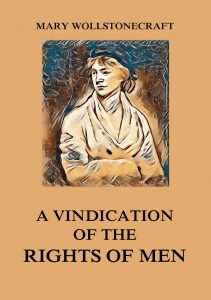A Vindication of the Rights of Men – Mary Wollstonecraft
In 1790 came that “extraordinary outburst of passionate intelligence,” Mary Wollstonecraft’s reply to Edmund Burke’s attack on the principles of the French Revolution entitled a “Vindication of the Rights of Men.” In this pamphlet she held up to scorn Burke’s defence of monarch and nobility, his merciless sentimentality. “It is one of the most dashing political polemics in the language,” Mr. Taylor writes enthusiastically, “and has not had the attention it deserves. . . . For sheer virility and grip of her verbal instruments it is probably the finest of her works. Some of her sentences have the quality of a sword-edge, and they flash with the rapidity of a practised duellist. It was written at a white heat of indignation; yet it is altogether typical of the writer that, in the midst of the work, quite suddenly, she had one of her fits of callousness and morbid temper, and declared she would not go on. With great skill Johnson persuaded her to take it up again; and with equal suddenness her eagerness returned, and the book was finished and published before any one else could answer Burke.”
Format: Paperback
A Vindication of the Rights of Men.
ISBN: 9783849681043
Available at amazon.com and other venues.
Biography of Mary Wollstonecraft (from Wikipedia):
Mary Wollstonecraft (27 April 1759 – 10 September 1797) was an English writer, philosopher, and advocate of women’s rights. During her brief career, she wrote novels, treatises, a travel narrative, a history of the French Revolution, a conduct book, and a children’s book. Wollstonecraft is best known for A Vindication of the Rights of Woman (1792), in which she argues that women are not naturally inferior to men, but appear to be only because they lack education. She suggests that both men and women should be treated as rational beings and imagines a social order founded on reason.
Until the late 20th century, Wollstonecraft’s life, which encompassed several unconventional personal relationships, received more attention than her writing. After two ill-fated affairs, with Henry Fuseli and Gilbert Imlay (by whom she had a daughter, Fanny Imlay), Wollstonecraft married the philosopher William Godwin, one of the forefathers of the anarchist movement. Wollstonecraft died at the age of 38, eleven days after giving birth to her second daughter, leaving behind several unfinished manuscripts. This daughter, Mary Wollstonecraft Godwin, became an accomplished writer herself, as Mary Shelley, the author of Frankenstein.
After Wollstonecraft’s death, her widower published a Memoir (1798) of her life, revealing her unorthodox lifestyle, which inadvertently destroyed her reputation for almost a century. However, with the emergence of the feminist movement at the turn of the twentieth century, Wollstonecraft’s advocacy of women’s equality and critiques of conventional femininity became increasingly important. Today Wollstonecraft is regarded as one of the founding feminist philosophers, and feminists often cite both her life and work as important influences.
(The text of the last section was taken from a Wikipedia entry and is available under the Creative Commons Attribution-ShareAlike License.)
Publisher’s Note: This book is printed and distributed by Createspace a DBA of On-Demand Publishing LLC and is typically not available anywhere else than in stores owned and operated by Amazon or Createspace.

